WARTIME HEAVY FREIGHT
In times of national crisis our railways are often called on to perform extraordinary feats, and in the Second World War freight traffic rose to such an extent that a special breed of locomotive was required to deal with it. EVAN GREEN-HUGHES explains all.
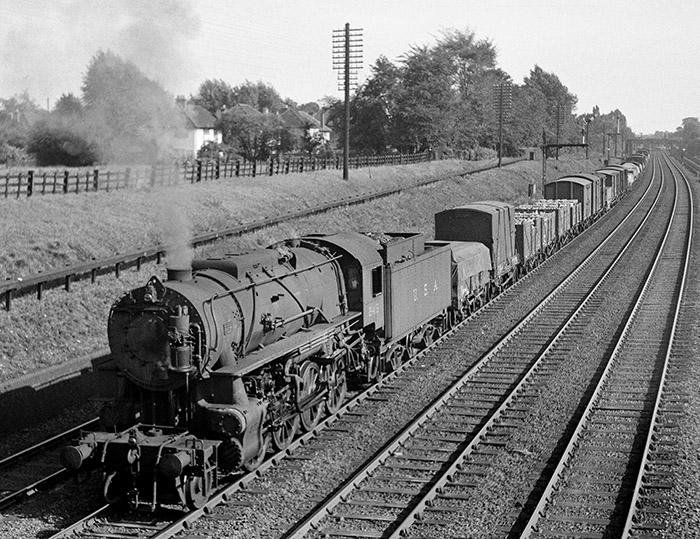
Above: The USATC ‘S160’ 2-8-0s were distinctive for their American outline and came to the British railway system in kit form. In 1944 ‘S160’ 2415 has just passed Hatch End with a down freight on the West Coast Main Line. C.R.L. Coles/Rail Archive Stephenson.
TODAY it is hard for us to appreciate the impact the declaration of war between Britain and Germany had on our railway system just over 80 years ago. Express passenger train services, for many the focus of attention in normal times, were slashed or done away with while local trains began to run to reduced frequencies as all but essential travel was banned.
On the goods front, local pick-up freights ran as normal with some adjustments to the loadings caused by restrictions on purchases and rationing - but there was a sudden and massive jump in demand for long-distance and heavy freights, for which our railway was not well prepared.
Naturally, much of this demand related to the movement of materials for the manufacture of fighting vehicles and weapons, and then their subsequent transfer to the place where they would be required, but there were also extra trains of coal, as well as countless trains full of troops to be considered. Later there would be ambulance trains and the sorry sight of evacuation trains full of children being taken away to temporary places of safety.
The railways had been placed on a war footing by, to all intents and purposes, being taken into government control and thoughts initially centred round supporting the war effort in France, which had not at that time been invaded by the Germans. Robert Riddles, at the time the LMS’ Mechanical and Electrical Engineer for Scotland found himself seconded to the Ministry of Supply with the task of hurriedly arranging motive power to support the British Expeditionary Force and initially the use of the Robinson ‘O4’ 2-8-0s was considered, a Great Central design which had proved extremely successful in the first conflict. At the Ministry’s request 300 examples of this numerous class were requisitioned for service in France from the LNER, and 57 of them were fully prepared for shipping before there was a change of heart and the proposal was dropped.

Above: Britain’s answer to the requirement for heavy freight locomotives was to create the ‘WD’ 2-8-0 and 2-10-0 - a rugged cost and material saving design which could step in on a wide range of goods work. In 1945 ‘WD’ 2-8-0 77091 passes Hatch End with a down train of coal empties. C.R.L. Coles/Rail Archive Stephenson.
MODERN UPGRADES
It had been realised that, reliable though the ‘O4’ was, it was an old design and that something more up-to-date would be required to supplement the domestic railways and for service overseas. As Riddles was an LMS man it is perhaps not surprising that he looked towards that company’s ‘8F’ 2-8-0 (see Reality Check in HM156) to fill the gap, but this was actually a sound decision as it was a simple two-cylinder machine with many advanced features, but was also to a design some 20 years more up-todate than could be offered by either the GWR or the LNER. The Southern being a predominately passenger railway did not have a locomotive of this type.
Orders for no less than 240 of the ‘8F’ were therefore put in hand by the government with construction being shared » between main line railway workshops and those of several independent contractors. These, however, differed from those previously constructed, mainly due to a lack of suitable materials. The main frames were made of mild instead of high tensile steel and had to be increased in thickness to compensate. Coupling rods were also of mild steel instead of manganese while pins and bushes replaced the needle bearings formerly used. There were some additions, too, predominantly train air brake equipment, but some also received French-style speed recorders.
Although construction of these engines was swiftly undertaken none had been completed by the time Allied forces were pushed back to the beaches at Dunkirk and therefore instead of being sent overseas the ‘8Fs’ were allocated to UK railway companies where they were gladly taken up to assist in working the ever-growing number of freight trains. More ‘8Fs’ were added to stock as the war progressed, though most were ordered directly by the railway companies rather than by the War Office itself.
CUT-PRICE ‘8F’
With materials becoming scarce during wartime, but with the demand for heavy freight locomotives continuing to rise as the years went by, proposals were set in motion to produce a revised version of the ‘8F’ which would be simpler to construct and use fewer materials. The proposals saw the taper boiler of the ‘8F’ replaced with a parallel type with a round-top firebox. Many parts such as frame stretchers were fabricated instead of cast, while cast iron was used for most of the driving wheels instead of steel. A massive tender was also supplied which enabled the engines to work for long periods without the need for refuelling.
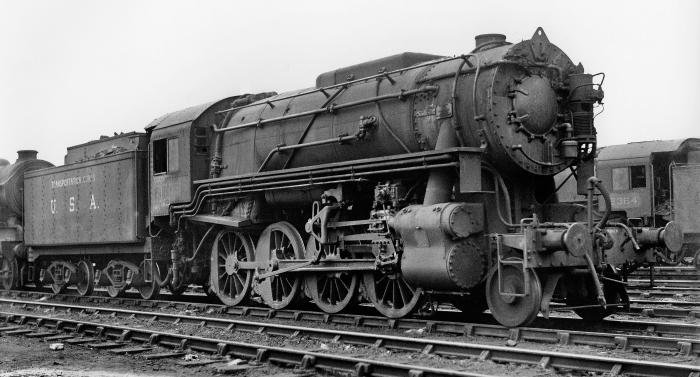
Above: USATC ‘S160s’ were operated by all of the ‘Big Four’ railway companies with just shy of 400 examples entering service collectively. ‘S160’ 1705 shows its rugged design at Stratford shed on April 1 1944. Rail Archive Stephenson.
This locomotive, which became known as the War Department 2-8-0, or ‘WD’ to enthusiasts was quickly put into production with the first example taking to the tracks in April 1943. Within a year 935 had been built because sooner or later the Allies were going to return to France. Once that had been achieved a large number of freight engines were going to be needed to haul the trains which would supply the advancing army. The ‘WDs’ were constructed by the North British Locomotive Company in Glasgow and Vulcan Foundry at Newton-le-Willows and while some were stored awaiting the forthcoming invasion, 450 of them were loaned to British companies, with 350 of these being taken by the LNER. These locomotives proved to be invaluable in assisting with the movement of armour and materials towards the south coast and were used extensively until they were recalled by the Government in June 1944. Later they were shipped abroad where many of them assisted in the successful liberation of Europe.
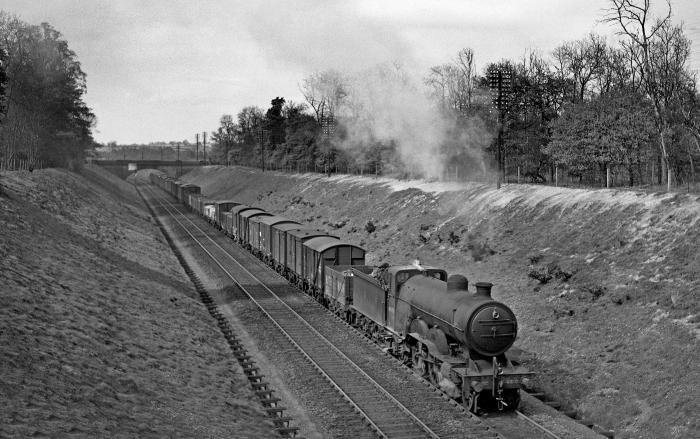
Above: Such was the demand for motive power that passenger engines were called up to haul freight during the conflict. On May 12 1940 Ivatt ‘C1’ 4-4-2 4460 passes Jericho Wood south of Barkston Junction with an Up goods. John P. Wilson/Rail Archive Stephenson.
A PRE-BR ‘9F’?
A second version of the ‘WD’ was also produced which had an additional driving axle to provide a 2-10-0 wheel arrangement. This version was intended for use on some of the more poorly-laid lines which were known to exist on the continent and had a lighter axle load because of the additional wheels. Most of the other components were the same as the 2-8-0, except for the firebox which was wider. North British was responsible for the construction of this variant which extended to 150 examples in two batches between 1943 and 1945.
Examples of this class were run in on UK railways but were not routinely used due to their length and wheel arrangement which precluded them from many lines. All were sent abroad for war service with 20 of them working in the Middle East and the rest mainly being allocated to France. Although these were not to find favour in the UK, the bulk of the class did pass to Dutch Railways after the war and assisted that country to rebuild its system after several years of destruction.
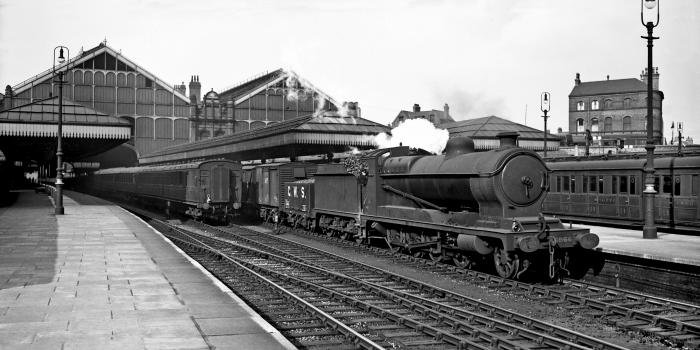
Above: The robust Robinson ‘O4’ 2-8-0s were originally proposed for overseas service during the Second World War, but ultimately a more modern design was favoured. Nevertheless, these 2-8-0s continued to serve at home on heavy freights. The pioneer of the class, 5966, passes through Nottingham Victoria with an Up goods on March 23 1940. John P. Wilson/Rail Archive Stephenson.
THE YANKS ARRIVE
By the time the ‘WD’ was in production the United States of America had entered the war on the side of the allies. The country had a highly-developed army railway division, known as the Army Transportation Corps, which was itself gearing up for the invasion of Europe. As with the home troops, there was a need for a basic heavy freight locomotive, and once again the 2-8-0 wheel arrangement was selected for this purpose. What was to become known as the ‘S160’ class was developed by Major J W Marsh of the Corps of Engineers from a pre-war design, being re-scaled to fit the UK and European loading gauge. It was also redesigned so it used the minimum of materials and could be assembled in the least possible time.
As with the ‘WD’, fabricated components were used wherever possible in place of castings, although the frames themselves were castings, and were designed in this way to reduce assembly time. Modifications were made to the springing to enable the locomotives to be used on poor-quality track and again a large, eight-wheel tender was supplied, in this case mounted on bogies, rather than a fixed wheelbase as had been used on the ‘WD’.
Construction of the ‘S160’ began in 1942 and 800 locomotives were built within a year, with Baldwin, Alco and Lima all producing examples. Engines were then shipped to Britain in a partially-assembled state with the usual port of arrival being Newport in South Wales. Final assembly took place at Ebbw Junction although some were taken to Doncaster for this work to be completed. After running in, some locomotives were made available for use on the home front with the GWR taking 174 of them, the LNER 168, the LMS 50 and the Southern only six.
In practice the ‘S160’ was found to have a few shortcomings, with a particularly dangerous issue being weaknesses in the firebox stays, an issue which resulted in the death of one GWR fireman. There were also instances of hot axleboxes which were traced back to problems with the mechanical lubrication system, and the provision of only one water glass for the boiler was seen as a major problem. However, once these troubles were ironed out the ‘S160s’ began to give sterling service alongside their British-built cousins.
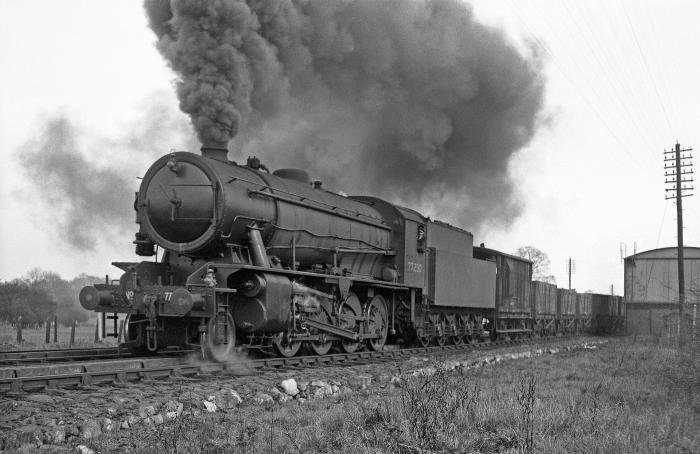
Above: ‘WD’ 2-8-0 77230 darkens the sky as it passes over Ruislip water troughs with a down train of coal empties for Woodford shortly before being sent to the continent in 1945. This engine later became Dutch State Railways 4415 before returning to the UK as BR No 90198. C.R.L. Coles/Rail Archive Stephenson.
MAINLAND SERVICE
As with the ‘WDs’ and the ‘8Fs’, the ‘S160s’ were recalled in time to support the invasion of Europe and in time all went abroad, where they were joined by many more which were shipped directly to the continent from the USA. Eventually no fewer than 2,120 were built and the class had a major effect on the transport of goods in the final couple of years of the war and for decades afterwards. After the conflict many examples were obtained by European railways and they were to be found in France, Austria, Czechoslovakia, Italy, Greece and Poland. However, none returned to Britain after the conflict, presumably because their design features were too American when compared with the ‘WD’ type, of which in any case there was an ample supply available from the War Office.
By 1945 the fighting was over but it was to be many years before there was true stability in both our country and in Europe. Materials to rebuild towns and cities still had to be transported and support also had to be given to industry as it made the transition from wartime to peacetime production once again.
The wartime heavy freight engines rose to the challenge and many of them lasted until the 1960s and the 1970s doing exactly the sort of job they were designed to do. In fact, the relative simplicity of wartime engines proved to be a positive boon both at home and overseas particularly in the early years, when maintenance facilities were often not yet fully rebuilt.
While many of the stories of the Second World War are well-known, that of our railwaymen and their heavy freight engines are less so. Perhaps now, on the anniversary of the D-Day landings, it is a suitable time to remember that contribution and its effect on the successful resolution of that conflict.

